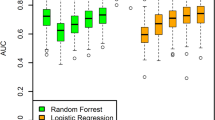Abstract
Pathological speech, in its many forms, is a symptom of numerous serious diseases affecting millions of people worldwide, including more than 10 million Parkinson patients. Here, a powerful method is proposed for detecting pathological speech, using a two-dimensional (2D) convolutional neural network (CNN). Spectrograms are extracted from voice recordings of healthy and Parkinson diagnosed patients, which are fed into the CNN architecture. The voice samples comprise a subset of the benchmark mobile Parkinson Disease (mPower) study. The proposed model achieves 98% accuracy in Parkinson detection (i.e., a two-class problem). Moreover, an average accuracy exceeding 94% is measured in binary tests (i.e., pathological versus healthy) employing six voice pathologies conducted on the Saarbruecken Voice Database. These pathologies are dysphonia, functional dysphonia, hyperfunctional dysphonia, spasmodic dysphonia, vocal fold polyp, and dysody.
Access this chapter
Tax calculation will be finalised at checkout
Purchases are for personal use only
Similar content being viewed by others
References
Huang X, Acero A, Hon H-W (2001) Spoken language processing: a guide to theory, algorithm, and system development, 1st edn. Prentice Hall, Upper Saddle River
Mosley AD, Romaine DS (2004) The encyclopedia of Parkinson’s disease, 1st edn. Facts on File, New York
Factor SA, Weiner WJ (2008) Parkinson’s disease: diagnosis and clinical management, 2nd edn. Demos, New York
Schwartz SR, Cohen SM, Dailey SH, Rosenfeld RM, Deutsch ES, Gillespie MB, Patel MM (2009) Clinical practice guideline: hoarseness (dysphonia). Otolaryngol Head Neck Surg 141(1_suppl):1–31. https://doi.org/10.1016/j.otohns.2009.06.744
Kotropoulos C, Arce GR (2009) Linear discriminant classifier with reject option for the detection of vocal fold paralysis and vocal fold edema. EURASIP J Adv Signal Process 2009:203790. https://doi.org/10.1155/2009/203790
Lee JW, Kang HG, Choi JY, Son YI (2013) An investigation of vocal tract characteristics for acoustic discrimination of pathological voices. Biomed Res Int 2013:758731
Wroge TJ, Özkanca Y, Demiroglu C, Si D, Atkins DC, Ghomi RH (2018) Parkinson’s disease diagnosis using machine learning and voice. In: 2018 IEEE signal processing in medicine and biology symposium. IEEE, Philadelphia, pp 1–7
Valstar M, Schuller B, Smith K, Eyben F, Jiang B, Bilakhia S, Schnieder S, Cowie R, Pantic M (2013) AVEC 2013: the continuous audio/visual emotion and depression recognition challenge. In: 3rd ACM international workshop on Audio/visual emotion challenge. Association for Computing Machinery, New York, pp 3–10
Bot BM, Suver C, Neto EC, Kellen M, Klein A, Bare C, Doerr M, Pratap A, Wilbanks J, Dorsey ER, Friend SH, Trister AD (2016) The mPower study, Parkinson disease mobile data collected using Researchkit. Sci Data 3:160011
Ciccarelli G, Quatieri TF, Ghosh SS (2016) Neurophysiological vocal source modeling for biomarkers of disease. In: 17th Annual Conference of the International Speech Communication Association, INTERSPEECH 2016. ISCA, San Francisco, CA, pp 1200–1204
López JVE, Orozco-Arroyave JR, Gosztolya G (2019) Assessing Parkinson’s disease from speech using Fisher vectors. In: 20th Annual Conference of the International Speech Communication Association, INTERSPEECH 2019. ISCA, Graz, Austria, pp 3063–3067
Fayek HM, Lech M, Cavedon L (2017) Evaluating deep learning architectures for Speech Emotion Recognition. Neural Netw 92:60–68
Dabeer S, Khan MM, Islam S (2019) Cancer diagnosis in histopathological image: CNN based approach. Inform Med Unlocked 16:100231
Pratt H, Coenen F, Broadbent DM, Harding SP, Zheng Y (2016) Convolutional neural networks for diabetic retinopathy. Procedia Comput Sci 90:200–205
Putzer M, Barry WJ (2007) Saarbrucken voice database. Institute of Phonetics, Universität des Saarlandes. http://www.stimmdatenbank.coli.uni-saarland.de
McFee B, Raffel C, Liang D, Ellis DP, McVicar M, Battenberg E, Nieto O (2015) Librosa: audio and music signal analysis in Python. In: 14th Python in Science Conference. SciPy, Austin, TX, pp 18–24
Teixeira JP, Oliveira C, Lopes C (2013) Vocal acoustic analysis-jitter, shimmer and HNR parameters. Procedia Technol 9:1112–1122
Harar P, Alonso-Hernandezy JB, Mekyska J, Galaz Z, Burget R, Smekal Z (2017) Voice pathology detection using deep learning: a preliminary study. In: 2017 International Conference and Workshop on Bioinspired Intelligence. IEEE, Funchal, Portugal, pp 1–4
Wu H, Soragan J, Lowit A, Di-Caterina G (2018) A deep learning method for pathological voice detection using convolutional deep belief networks. In: 19th Annual Conference of the International Speech Communication Association, INTERSPEECH 2018. ISCA, Hyderabad, India, pp 446–450
Alhussein M, Muhammad G (2018) Voice pathology detection using deep learning on mobile healthcare framework. IEEE Access 6:41034–41041
Roy S, Sayim MI, Akhand MAH (2019) Pathological voice classification using deep learning. In: 1st International Conference on Advances in Science, Engineering and Robotics Technology. IEEE, Dhaka, Bangladesh, pp 1–6
Acknowledgments
Data was contributed by users of the Parkinson mPower mobile application as part of the mPower study developed by Sage Bionetworks and described in Synapse [9].
The authors are also grateful to Manfred Pützer and William J. Barry, Institut für Phonetik, Universität des Saarlandes for granting access to SVD [15].
Author information
Authors and Affiliations
Corresponding author
Editor information
Editors and Affiliations
Rights and permissions
Copyright information
© 2021 The Author(s), under exclusive license to Springer Nature Switzerland AG
About this paper
Cite this paper
Almaloglou, E.E.I., S, G., Chrousos, G., K, K. (2021). Design and Validation of a New Diagnostic Tool for the Differentiation of Pathological Voices in Parkinsonian Patients. In: Vlamos, P. (eds) GeNeDis 2020. Advances in Experimental Medicine and Biology, vol 1339. Springer, Cham. https://doi.org/10.1007/978-3-030-78787-5_11
Download citation
DOI: https://doi.org/10.1007/978-3-030-78787-5_11
Published:
Publisher Name: Springer, Cham
Print ISBN: 978-3-030-78786-8
Online ISBN: 978-3-030-78787-5
eBook Packages: Biomedical and Life SciencesBiomedical and Life Sciences (R0)




